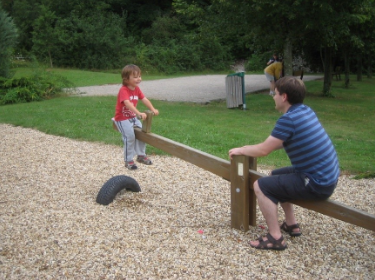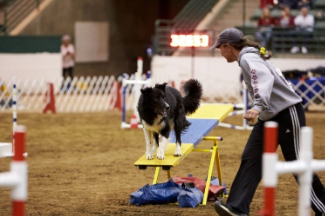
Learning Objectives
Plan and conduct an investigation to provide evidence of the effects of balanced and unbalanced forces on the motion of an object.
Predict the effect of a given force or change in mass on the motion of an object.
Grade Levels
Grades 3-5
Grades 3-5 Next Generation Science Standards
PS2.A: Forces and Motion
Each force acts on one particular object and has both strength and a direction. An object at rest typically has multiple forces acting on it, but they add to give zero net force on the object. Forces that do not sum zero can cause changes in the object’s speed or direction of motion.
Materials Needed
Resources:
Video of a Papillon completing Agility course. Note how the seesaw moves. https://youtu.be/furXOMBppQg
Australian Shepherd completing Agility course. https://youtu.be/ND2wihZiR_Q
Mastiff completing Agility course. Note when the seesaw tilts. https://youtu.be/pCQRvH_o4v0
Wide craft sticks (enough for each student to have one)
Clay (can be air hardening or not), enough for each student to have about ¼ cup
Lesson
This lesson works best as a continuation of students’ exploration of forces and motion, rather than an introduction to the concept. Students should be familiar with the following vocabulary:
Vocabulary
Force: energy applied to move an object
Motion: an act of an object changing its location
Inertia: an object in motion stays in motion. An object at rest stays at rest.
Inertia is related to mass.
Fulcrum: the support or point of rest on which a lever turns
Balanced forces: equal and opposite forces
Unbalanced forces: forces that cause a change in motion of an object
Introduction
- Review the vocabulary terms above. A fun way to review vocabulary is to play a version of the game Headbandz. Students play with a partner or in small groups. Before starting the game, write each vocabulary word on an index card, making sure there are enough for each small group or partner pair. When it is their turn, students select a card without seeing what their word is. They hold the card up on their forehead so their teammate(s) can see it. Teammate(s) give clues to the student about the word, without using the word itself, or parts of the vocabulary word, or words that rhyme with the target word. Clues must be related to the target word’s definition.
- After a couple rounds of the game, as students to tell you what they remember about what they’ve already learned about force and motion.
- Show students a picture of a perfectly balanced seesaw. Ask students to name the parts of the picture and tell what forces are working on the balanced seesaw. (The seesaw is a lever with a fulcrum, and gravity is pulling equally on both sides of the lever because the fulcrum is in the middle. Inertia means that the seesaw will not move unless another force works on it, like a person sitting on one of the sides.)
Example image:

Explicit Instruction/Teacher Modeling
- Ask students if they’ve ever seen a dog go through an Agility Course.
- If any students have, ask them to describe the obstacles the dogs go through.
-
- Let students know that dogs who complete an AKC Agility Course learn to climb onto a seesaw and then make it tilt, touch the ground on the other side, and climb off the other end. This can be scary for most dogs, so it takes a lot of practice and rewarding from their trainer to be able to complete this obstacle.
- Any size dog can compete in AKC Agility, as well as any breed, including All American dogs.
- Ask students to predict what will happen when three different sized dogs complete the seesaw portion of an Agility Course.
- Discuss student predictions.
- Students watch the videos of three different sized dogs completing an Agility Course. (See links above.)

Independent Working Time
After watching the three videos, students answer these questions (a student copy is provided above):
- If the seesaw is perfectly balanced, are any forces working? (Yes,the forces are balanced.) If no other force is acting on it, will it stay level? (Yes, another force must act on it to get it to tilt one direction or the other.)
- How can a Papillon, an Australian Shepherd, and a Mastiff all make thesame seesaw tilt? (They are different sized dogs and therefore have different masses. They will need to step further from the fulcrum as their mass decreases in order to make the lever tip.)
- What differences did you notice in the way the three different sized dogs made the seesaw tilt? (The Mastiff barely passed the fulcrum before the seesaw started tipping. The Australian Shepherd went farther than the Mastiff, and the Papillon had to go way far out on the seesaw to get it to tip down.)
- How far from the fulcrum do theMastiff, the Australian Shepherd, and the Papillon need to be to tilt the seesaw? (Mastiff—large dog—close, Australian Shepherd—medium dog—a bit farther, Papillon—tiny dog—very far from fulcrum)
- Why does the Papillon need to be fartherfrom the fulcrum than the other two dogs in order to tilt the seesaw? (The Papillon has less mass and therefore gravity is not pulling on the Papillon as much as it is on the other two dogs.)
Hands on investigations:
- Students experiment with a seesaw on the playground, seeing how close to the fulcrum they can get before it starts tipping the other direction.
- Students try to balance the seesaw by placing students or toys in various spots until the seesaw is level. Experiment with distance from fulcrum and number of students on the equipment.
- Students create a seesaw using craft sticks and wedges made of clay. Students try to balance the seesaw, and then add weights (or counting bears or pennies) to try to unbalance and rebalance the seesaw. Replicate the three different sized dogs by using different weights (i.e. different numbers of pennies, or different sized counting bears/manipulatives).
- Students can also explore what happens when you move the fulcrum. Challenge students to try to balance two different sized manipulatives (or 3 pennies on one side, 1 penny on the other) by moving the fulcrum.
- A fun, interactive model for a seesaw with two different sized people using it, can be found at http://www.fearfphysics.com/Seesaw/seesaw.html. Using this model, students can move the large person, the small person, and the fulcrum, to find out how they interact.
- Make sure students select “Off” for the bullet point “Turn the Physics on or off.” Turning the physics on provides a description of the torque applied by the larger and smaller person. This is more appropriate for older students.
Review and Closing
- Discuss student responses to the question sheet, and questions/observations that arise from the hands on investigations.
- Some students may be ready to try to theorize rules about how far a person or object needs to be from the fulcrum in order to balance a different sized object on the other side of the seesaw

